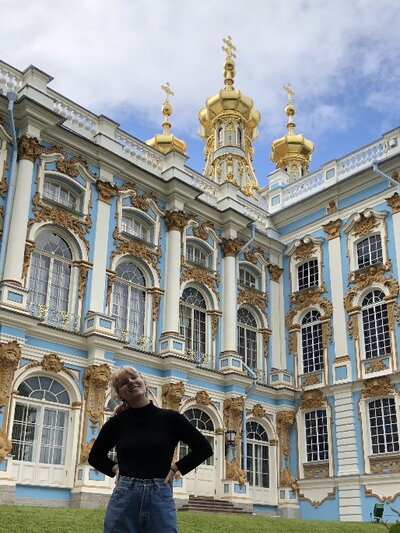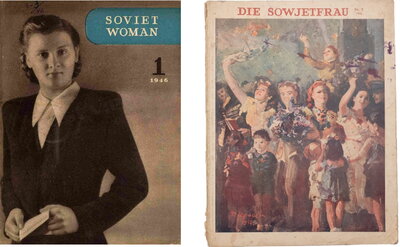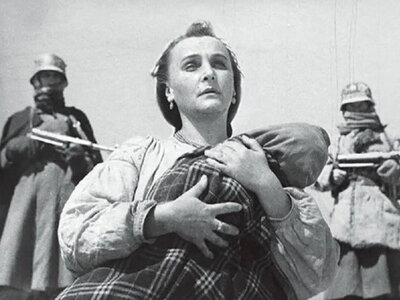By Karina Povsteva (PhD student, Slavic Languages and Literatures)

Tori Paige is a PhD Candidate in the Department of History, The Ohio State University, and the 2024 recipient of the Fisher Fellow Award. The Fisher Fellow Award offers support to junior scholars to attend the Summer Research Lab at the Russian, East European, and Eurasian Center at the University of Illinois in the spirit of scholarly advancement and collaboration. During her stay at the University of Illinois Urbana-Champaign, Tori gave a talk about her dissertation project Mother, Maiden, Martyr: Media Portrayals of Soviet Women in the Second World War. In the last week of Summer Research Lab, we met with Tori to talk about her research plans and the materials she found this summer in the collection of the University of Illinois.
The interview has been slightly edited for clarity.
How did you become interested in studying the role of Soviet women in war actions?
I feel it’s been a long time coming now! Well, I originally got interested in this because of the World War II class that I took in my sophomore year of college. That was the first time when I even learned that Soviet women had actually fought in the war and had participated in combat. I think in American History classes we tend to only portray obviously the American side of World War II, emphasize that the war was won by the US, whereas in fact it was the Soviet Union that took the brunt of it. And then my professor recommended that I read Svetlana Alexievich’s The Unwomanly Face of War. This book is a collection of interviews with female veterans who participated in the war both in combat and rear positions. Once I learned about this topic, I decided to stick with it for my further research.
In your talk you mentioned that you have gathered a lot of new valuable materials from Slavic collection at the University of Illinois. What exactly are the sources that you’ve found?

The main sources that I went to Urbana-Champaign to look at were a couple of Soviet periodicals. The first one is a sociopolitical and literary magazine for peasant women “Krestyanka” which we don’t have over at OSU. Since I have already worked with pre-war and war editions of this magazine last year, this summer I focused more on the post-war editions. Now I have a full catalogue of “Krestyanka” issues at my fingertips! The second magazine that I looked at was “Soviet Woman” which neither OSU nor Library of Congress (surprisingly) supplies. I am glad that I got a chance to work with it at the University of Illinois Urbana-Champaign. “Soviet Woman” is an international magazine, it was translated into three other languages besides Russian since 1945 – English, French and German.1 I also had a chance to work with some collected war biographies and short stories that were published in 50s and 60s.
What did you find especially intriguing about these documents?
Well, I didn’t know much about the magazine “Soviet Woman”, for example, that it was intended to be published internationally. It implies that the same articles and images were presented for Soviet audience, but also for English, German and French speakers. I found myself wondering what it entails. Are these articles trying to create the connection between English speaking audience and Soviet women?
And what examples of building international connections did you find?
There is a very strong emphasis in magazines on motherhood and maternity which you would expect in the post-war period. Also, looks like it’s more emphasized in “Soviet Woman” than in “Rabotnitsa” and “Krestyanka”. You would find so many articles about mother-heroines with slogans like “We have to defend our children”, “We have to defend our peace”. One peculiar example is that a lot of articles in an English issue of “Soviet Woman” are about “housewives” which I assume was translated from “домохозяйка”. I can only guess that probably this “housewife” topic was included in the journal to connect Soviet women’s way of living with that of English-speaking women, although the women in these articles were not housewives in the English-speaking sense. It stands in contrast to the more typical ideological themes in the magazine, such as how to become a best worker.
Since we started discussing maternity and motherhood, I am curious to hear more about your thoughts on the connection between Soviet family policy and representation of women in war actions in Soviet media. Your examples in Fisher Fellow Talk suggest that in films women’s combatant role was mostly represented as marginal in sharp contrast to the domestic sphere where women can truly reveal their traditional role as caretakers. How does this opposition resonate with the Soviet maternity policy?
In 1944 there was a new family law passed that encouraged the revival of population. It became much harder for people to file for divorce, mothers were given state aid regardless of marital status, fathers did not need to pay child support outside of marriage. It means that men could have children with multiple women without any financial responsibility. Also, in the same year Soviet government created the Order of Maternal Glory, an award granted to women who have large families.
Indeed, I feel that the Soviet maternity policy affected the ways women were represented in war films – as mothers and wives rather than combatants.
I think throughout the entire period that I am studying there is always an expectation that a woman’s primary duty is to be a mother. The question is whether she can add some other things opposed to her role as a potential mother. Can she be in a military, for example, or should she focus on maternal role instead?
Now I would like to talk more about the sources and perspectives for your topic. So far you have been focusing more on periodicals and films. Are you going to use examples from other Soviet media? And what are the other research perspectives that you find applicable to your topic?

I am planning to focus more on short stories and novels next year to see how female characters are portrayed in war stories. One of the new research perspectives that I am excited to look more into is the idea of disability. In the post-war period there were a lot of stories about returning male veterans who come back home with disability that they are afraid is going to impact their attempts to readjust to civilian life. They are worried that it can undermine their position as a head of their household, and this fear is assuaged by the end of the story. You don’t really have the same plot about women. Was it just because women weren’t the center of these exact stories or was something else going on? In fact, looking at the diaries and letters written during the war you can see women worrying about the potential of getting a disability and how it is going to impact their marital prospects, their femininity, and life after the war in general. So, I am planning to go deeper into the connection between disability on the one side and femininity vs. masculinity on the other side during and after the war.
Sounds like a great idea for pursuing this topic! What sources would you recommend for people interested in the representation of Soviet women on the frontline?
I would recommend The Unwomanly Face of War by Svetlana Alexievich, Anna Krylova’s book Soviet Women in Combat: A History of Violence in the Eastern Front. Erica Fraser wrote a monograph Military Masculinity and Postwar Recovery in the Soviet Union if you are interested in the post-war period. Luckily a lot of Soviet films that I am studying are available for free in Russian on YouTube.2 A lot of books have been translated, for example, Konstantin Simonov’s Days and Nights, The Living and the Dead, Boris Polevoy’s novel A Story about a Real Man.
1 Since the 1950s, the magazine began to be published in some other languages, including Spanish, Chinese, Korean, Japanese, and Hungarian.